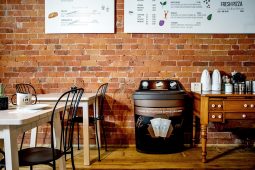
May 22, 2020 By Tim No Comments
For more information on how to build an exceptional recycling program in your next architectural design, click here.
An overview of the Economic, Social & Environmental benefits associated with building a solid waste management program.
The topic of eco-friendliness and zero waste have been rising in popularity in the architectural community. The pressure to incorporate environmental innovation in your work is stronger now than ever, and one of the best ways to do that is to consider waste management in your designs. Many architects have already taken steps to improve their waste programs such as adding advanced recycling and organics streams while developing a standardized and easy to follow system for all users. Getting future visitors on board with a seamless recycling program can drastically improve your building’s uniqueness and functionality in so many ways. Here’s a small list of major benefits to having a successful waste management program in your next design.
Economic Impact
Budget is always something that needs to be considered in any architectural design, so why go through the effort of implementing an advanced waste management program in your designs? It’s no secret that waste program upgrades can be costly, but there are many ways in which it can actually save money! In addition to the many obvious social and environmental upsides to recycling, here’s a list of economic benefits that you can propose to the builder or building manager:
- Drastically Reduced Waste Removal Costs:
Trash removal costs can be exorbitantly expensive, especially in dense cities or remote areas. By removing paper, plastic and other recyclables from the waste stream, facilities can cut their waste disposal bill by as much as 50 percent. Of course, every facility’s cost will differ, and there is always a cost involved in recycling collection. However, the price paid for recycling collection is often recouped by the savings of having less waste collected by your waste hauler.
- Promotes a healthy economy
In a study performed by Waste Wise, they point out that “Recycling is an important segment of the national and state economy, creates jobs and saves money for generators of waste. The businesses, institutions, and local government entities highlighted in this report all understand that recycling makes both environmental sense and economic sense”. The amount of jobs that the recycling industry sustains has a major impact on the overall economy. The healthier the general economy is, the more demand there will be for architectural development.
- Procurement of Recycled Materials
Many recyclable materials are valuable enough to sell and be reused. This not only promotes a circular economy but also creates a potential for cost savings from your client’s recycling hauler.
- Clean Restaurant Grounds
Providing more options and communicating a clear waste management system encourages people to refrain from leaving trash and litter in places they don’t belong. Not only can this improve the aesthetics and clean environment of the future building, attracting and pleasing more guests, but it can also reduce the hardship on janitorial or maintenance staff. Encouraging guests and staff to properly recycle and dispose of waste means that they are more likely to clean up after themselves, benefitting your design and the future building owner financially!
Social Impact
Many architectural firms and designers are involved with philanthropic organizations to promote their interest in the success of their community. Here’s a list of reasons why a proper waste management system promotes a healthier social environment:
- Designers that encourage recycling and organics collection send the message that they are passionate about the environment.
- Eco-friendly actions show a commitment to a greener future, which can help to empower guests and employees to further personal actions.
- Setting a green standard in the community creates more jobs. These jobs support a shared transition to a more sustainable and resilient society. In fact, the Institute for Local Self-Reliance reports that industries engaged in sorting and processing recyclable material employ 10 times more people than traditional waste disposal firms do.
- People tend to feel a sense of social pressure to participate in recycling themselves if they see that it is encouraged in buildings around their community.
- The same social pressure applies to keeping public spaces clean. Visitors and guests are more likely to use recycling and waste receptacles properly if the environment around them is litter-free, and the options of waste, recycling, and organics are provided.
Environmental Impact
The need for action to help save our planet becomes more crucial every day, and the pressure on architects to innovate is more intense than ever. One of the most effective ways for a building design to have a major impact is to expand collection beyond waste by including recycling and organics, while also communicating the program effectively.
By now you’re likely familiar with the main environmental benefits of recycling, but here’s a recap of what encouraging recycling in your next design can do for our planet:
- Recycling helps to reduce the pollution caused by waste as harmful chemicals and greenhouse gasses are often released from plastics and other recyclable materials in landfill sites
- Recycling reduces the need for raw materials so that the rainforests can be preserved, allowing natural habitats to remain safe.
- Large amounts of energy are used when making products from raw materials. Recycling requires much less energy and therefore helps to preserve natural resources.
Beyond these, the environmental benefits of recycling are plentiful, but have you considered the further benefits of including organics collection in your designs?
Some people believe that food will simply decompose once in the landfill, but this is not usually true. Diverting organic matter from the waste stream has many ecological benefits, including, but not limited to the following:
- Reducing methane emissions, a greenhouse gas 21 times more potent than CO2.
- Minimizing the formation of leachate, a toxic runoff which threatens ground and surface water.
- Returning nutrients to soil, which both improves soil health and reduces the need for chemical fertilizers.
- Boosts the ability of soil to retain water and decreases runoff.
Organics aside, landfills are a primary contributor to the greenhouse gas output of the United States. Decomposing garbage generates methane, which is about twenty times more effective than carbon dioxide at trapping heat in the Earth’s atmosphere, according to the Environmental Protection Agency. With that said, all the waste generated within a community ends up in landfills and has a direct negative impact on climate change.
As with any environmental change discussion, the common thought is that any of these efforts are just a drop in the bucket, however, your program designs have a much larger influence than you may think. Making these types of changes to your building’s waste management not only sets a standard for all other architects, but it also sets a positive example for every person who enters the building in the future, encouraging them to practice recycling and proper waste disposal in their everyday lives. Making changes to your building reflects your passion for the environment, and encourages potentially thousands of other people to re-consider their recycling habits.
—
Now that we’ve filled you in on the quick list of benefits, we’re confident that you will find further success in your own program improvements, and when you do, we hope you share it with us! We would love to hear your challenges, successes, and any other industry knowledge that you have to share so that we can continue to educate and update our resources for you and other architects in the future.












